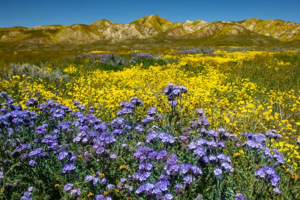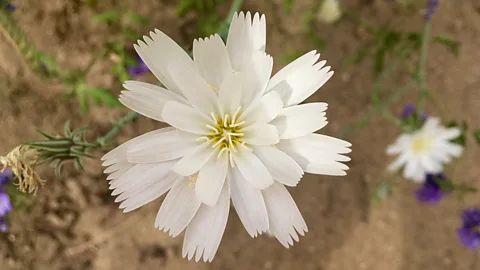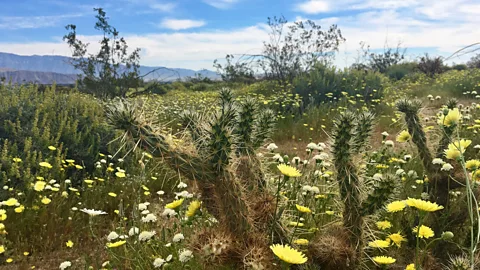 BBC — After record rainfall, California is poised for a wildflower “superbloom” in the next month. Conservation specialists weigh in on the phenomenon and how travellers can best catch it – without causing another ‘poppy apocalypse’.
BBC — After record rainfall, California is poised for a wildflower “superbloom” in the next month. Conservation specialists weigh in on the phenomenon and how travellers can best catch it – without causing another ‘poppy apocalypse’.Following a wetter-than-average winter, California’s deserts are starting to erupt in wildflower blooms, a palette of colours brightening the normally sandy-brown landscape.
“I’m swimming in an abundance of wildflowers here,” says Danny McCamish, senior environmental scientist at Anza-Borrego Desert State Park in eastern San Diego County, California.
There, bright purple sand-verbena, yellow desert sunflowers and creamy white dune evening primrose blanket swathes of the park.
“We’re experiencing a pretty impressive display of wildflowers. There are certain areas where we have field-covering carpets of wildflowers, which are really stunning,” McCamish says.
What is a “superbloom”?
Though not a scientific term, a so-called “superbloom” is when large quantities of spring wildflowers bloom at the same time, covering the desert ground for miles. This level of bloom is a relatively rare occurrence, since multiple factors have to line up for so many flowers to bloom at the same time in typically dry areas. Last year’s California “superbloom” was the first one in four years, and California State Parks is forecasting another “good” to “better-than-average” wildflower season this year.
“We’ve had a couple of springs in California that were really dismal and depressing… nothing came up, because it hardly rained at all,” says Naomi Fraga, the director of conservation programs at California Botanic Garden. “Those extreme dry years can be very sad, especially during spring.”
 Katie Watkins
Katie WatkinsThe environmental factors that cause this flower phenomenon
To germinate, wildflower seeds need enough rain, followed by cooler temperatures in the spring so that the plants can hold onto that water. Too much wind or sun can dry them out, and conditions can change quickly.
“If the temperatures rise too fast, and we get 90 or 100F (32 to 38C) temperatures in late March or early April, that could really dry out a lot of the seedlings before they have a chance to flower,” Fraga says.
Though Fraga doesn’t think this year’s superbloom will reach quite the same magnitude as 2023, when the flowers could even be seen from space, they still have high hopes for a “solid” superbloom.
“It can be very overwhelming to the senses,” says Fraga of the fields of wildflowers, which in addition to being stunning to see, can also emit strong fragrances. She explains that she came across a flower species last year that smelled “like ramen noodles”.
But the fields may also have a much more pleasant, rose-like smell, notes McCamish from Anza-Borrego Desert State Park.
“You can walk into one of these flower fields, and the fragrance hits you like a wall of overbearingly good rose,” he says.
 Katie Watkins
Katie WatkinsDifferent parts of California flower at different times, with blooms typically beginning in mid-March and going through May, depending on the location. California State Parks posts bloom updates along with visiting tips on their website. The Theodore Payne Foundation also has a wildflower hotline – voiced by actor Joe Spano – that gets updated weekly from March to May with the best spots to see the blooms.
Currently, Anza-Borrego Desert State Park is experiencing vast blooms, which will likely peak in the coming days, according to McCamish. The park has an interactive map with information on current blooms so visitors can plan accordingly.
Antelope Valley Poppy Reserve in the Mojave Desert is also starting to see some sporadic but notable poppy blooms. If the weather remains mild, blooms there are expected to be even better than last year’s, according to California State Parks. Visitors can see what it’s like ahead of time, on the reserve’s live PoppyCam.
These plants were abnormally large. Tall, robust and with big flowers – just huge – Naomi Fraga
Chino Hills State Park, Tule Elk State Natural Reserve, Ocotillo Wells State Vehicular Recreation Area and Picacho State Recreation Area are all starting to see blooms as well, according to California State Parks.
Death Valley, which got so much rain over the past six months that an ancient lake re-emerged, also has some surprising blooms. Fraga, who visited last week, says they’re not having a blanketing effect across the area, but they’re impressive to see because of how huge they are.
“The plants were enormous. They looked like they were juiced up,” says Fraga. “These plants were abnormally large. Tall, robust and with big flowers – just huge.”
Tips for viewing the wildflowers
In past years, thousands of visitors have flocked to the parks to see the wildflowers, causing traffic jams and in some cases damage to the natural habitat. In 2019, so many people visited Lake Elsinore to view the flowers that it was deemed the “poppy apocalypse” and officials had to close the area citing safety concerns.
California State Parks officials ask that those visiting stay on designated trails and refrain from trampling or picking the wildflowers, as doing so can prevent them from producing seeds.
“We welcome all Californians and visitors from around the world to experience this natural phenomenon and ask all to keep the ‘Beauty in the Bloom’ by staying on designated trails and taking only photos, not flowers,” says State Parks director Armando Quintero.
